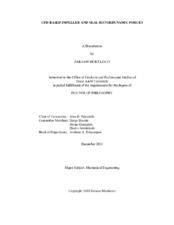| dc.description.abstract | Eccentrically operating turbomachinery components such as impellers and seals are subject to flow induced forces known as rotordynamic forces. Rotordynamic forces can be detrimental to the machine stability and longevity. Therefore, industrial guidelines, such as American Petroleum Institute level II stability criteria, require provision of advanced computational methods to predict the rotordynamic forces of impellers and seals. Current study aims to introduce Computational Fluid Dynamics (CFD) based methodologies with fewer restrictions compared to prior studies. Such generality encompass transient approaches as opposed to quasi-steady; asymmetric features such as primary flow paths, diffusers and volutes; open impellers compared to the classical case of closed impellers; multi-frequency modeling versus single-frequency approach; interaction with rotating stall; and dimensionless rotordynamic forces applicable to a spectrum of specific speed families. The evolution of CFD-based rotordynamic models in this work is initiated with a quasi-steady groove-on-rotor liquid annular seal case, followed by a transient single-frequency prediction of volute and diffuser rotordynamic forces, and further extended by a phase-modulated multi-frequency method applied to open impellers. All cases are validated against experimental data. The contribution of primary flow path, diffuser and volutes are found to be substantial despite the earlier belief that the majority of impeller rotordynamic forces stem from the front leakage path. Finally, a detailed discussion on the physical origins of fluctuations (bumps and dips) appearing on impeller impedances under partload operation is delivered.
In parallel, a CFD code has been developed in FORTRAN to model turbulent liquid annular seal flows as a long term goal to produce a CFD-based seal rotordynamic model. The Finite Difference Method (FDM) code utilizes McCormack (MCK) scheme along with the Pseudo-Compressibility Method (PCM) to solve Reynolds Averaged Navier-Stokes (RANS) equations in cylindrical coordinates. It was found that combination of MCK and PCM could successfully handle a diverse set of problems while accommodating high performance features such as collocated non-uniform grid, multigrid and parallel computing. | en |


